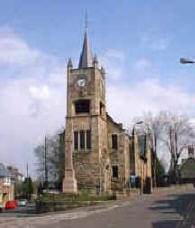 About Cambusbarron Village
About Cambusbarron Village
Cambusbarron is a quiet village located on to the southwest of Stirling and can offer visitors a welcome break from the hustle and bustle of life. Below are a few of the well known landmarks of the village. From this page you have the opportunity to visit more local views and learn a bit about the history of the village. Please feel free to take a virtual wander round the village by using the links on the left. The picture on the top right is of the Bruce Memorial Church.
The Bruce Memorial Church stands in the centre of Cambusbarron and acts as a focal point within the village. Sunday morning services are at 11am and there is always a warm welcome for any visitors. The current minister is Rev Graham Nash. The area in and around the village supports nine local businesses including a public house and a trout fishery namely Swanswater.
 Another
obvious land mark of the village is the old school house which was the
childhood home of Dr Grierson. Dr John Grierson CBE, born in 1898 in
Perthshire, Scotland, was the son of a local school headmaster. His fame
in the film industry as the pioneer of documentary film came when he
produced for the Empire Marketing Board a documentary - Drifters - about
the herring fishing fleets. This received wide critical acclaim at its
first public showing in London in 1929 with the British premier of
Eisenstein’s Battleship Potemkin.
Another
obvious land mark of the village is the old school house which was the
childhood home of Dr Grierson. Dr John Grierson CBE, born in 1898 in
Perthshire, Scotland, was the son of a local school headmaster. His fame
in the film industry as the pioneer of documentary film came when he
produced for the Empire Marketing Board a documentary - Drifters - about
the herring fishing fleets. This received wide critical acclaim at its
first public showing in London in 1929 with the British premier of
Eisenstein’s Battleship Potemkin.
The historically important Gillies Hill is an area of woodland close to Cambusbarron. It is composed of trees including Wellingtonias and Scots Pines and is home to a variety of rare animal life, including red squirrels, Peregrine Falcons, Roe Deer and Buzzards. It is the site of an Iron Age fort designated a Scheduled Ancient Monument, and is believed to have been the location of Robert the Bruce's camp prior to the Battle of Bannockburn in 1314.
Gillies Hill is also the site of the Murrayshall Quarry. Permission to begin extraction of stones from a small section of the hill was granted in 1982, but by 1996 the quarry had become dormant. In 2007 a proposal by Heidelberg Cement and Tarmac to reopen the quarry on a larger scale led to fierce local opposition and the formation of the Save Gillies Hill group to campaign against the proposal. The Stirling Council on 1st March 2012 required the quarry operators to comply with certain requirements related to;
- production of an Environmental Impact Assessment (EIA)
 (3.24.4)
(3.24.4) - update quarry restoration plan (3.24.5)
- provision of fencing (3.24.7)
The Council also decided that failure to comply with these requirements would lead to the Council starting the process of issuing a Suspension Order (SO) for the current permission. You can find further informtaion on the "Save Gillies Hill" Gampaign by Clicking Here
If you have any old or interesting photographs,
stories or memories pertaining to Cambusbarron that you would like
published on the website then contact us via
the
contact page.